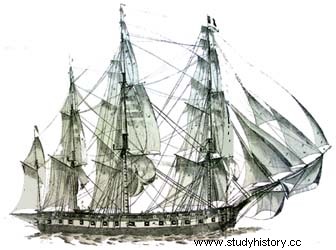Frigates appeared in the 16th century, during the golden age of the galleons. They were then small fast warships, with an open deck and lightly armed (an evolution of the simple rowing boat and lateen sail equipped with one or two pieces of artillery).
Between the 16th and 19th centuries, frigates evolved into medium-sized warships with an artillery deck carrying medium-caliber guns (24 pounds) and gun carriages on the upper deck. They were faster and more maneuverable than the ships of the line while retaining great autonomy, a large radius of action and significant military capabilities. In the mid-19th century, the British and French began to refer to their large long-range frigates as cruisers.

The frigates were at that time the most active vessels, they were constantly kept operational, unlike large ships of the line which were often disarmed and kept in port in times of peace, because the cost of their maintenance was prohibitive. The frigates therefore constituted in peacetime, the bulk of the active fleet and the best crews and leaders served there.
In wartime, they carried out reconnaissance missions (role of aviso) or liaison (real estafettes of the seas, they conveyed orders and important messages) for the line fleets, and attacked commercial convoys by practicing war racing, singly or grouped in small units. They were thus often commissioned as corsair ships and accomplished exploits like those of Robert Surcouf or René Duguay-Trouin.
The larger models could compete with smaller ships of the line (in Royal Navy terminology, frigates were ships of the 4th, 5th or 6th ranks) and sometimes fought as part of a squadron.
Frigates have often represented the state of the art of sailing, both in terms of rigging and hull design; around the 1800s, a good walker could sail in the 12 knots, remarkable speed for the time. Their armament could range from 16 to 22 guns on one deck (La Confiance de Surcouf, for example) up to 74 guns on two decks (La Belle-Poule of 60 guns, which brought back the ashes of Napoleon from Saint-Hélène) which appeared in the 19th century. It usually ranged from 32 to 44 guns, 8 to 24 pounds (3.6 to 11 kg) plus a few carronades.
The old frigates were classified first, according to the caliber of the guns of the first battery, expressed by the mass of the cannonball in pounds:
* ship-frigate of 8 or 12 on the second battery, the first battery having only a few guns of 18 or 24 pounds around 1640 to 1756,
* light frigate of 6 with about 150 men circa 1659 to 1744,
* frigate of 8 with approximately 200 men circa 1740 to 1744,
then, by the number of guns on board (we then spoke of a first or second rank / class frigate in some navies):
* 12 or 32 frigate with around 250 men around 1748 to 1798,
* 18 or 40 frigate with around 315 men around 1781 (American Revolutionary War) to 1813 ,
* 24 or 50 frigate with around 430 men around 1772 to 1843,
* 30 or 60 frigate with around 500 men around 1805 to 1846 which are the culmination of the sailing navy with the only caliber of 30 pounds. The various frigates, circa 1830, of 40, 50, or 60 guns had an assortment of short, medium, and long guns, all 30-pounders. These calibers are also found on ships and corvettes of the time, the only different caliber concerning the naval howitzer.
The transition from one class to another was done empirically at first. No class was codified before the 18th century.
After the steam made its appearance (1840-1860), the steam frigates were then the fastest boats. With the systematization of armor, they finally evolved into cruisers at the end of the 19th century, the term falling into disuse.
The term frigate reappeared in the British navy during the Second World War to designate ships larger than corvettes, but smaller than destroyers, and responsible for escorting convoys. These ships mainly had anti-submarine armament and equipment, leaving aside the armament for combating surface ships, in particular, torpedoes. They were slower than the destroyers, because they mainly escorted freighters that spun less than twenty knots, but also more enduring, especially in rough seas, because they had to fulfill their mission along the entire length of the Atlantic. In their tasks and size, they closely resembled destroyer escorts.
